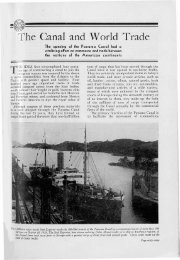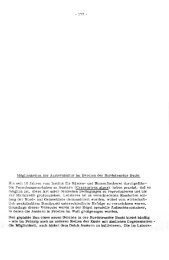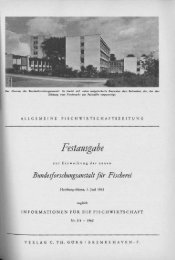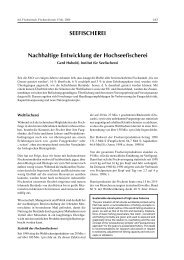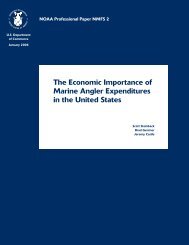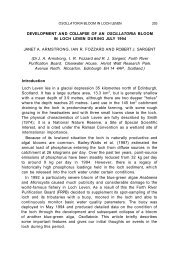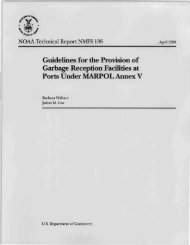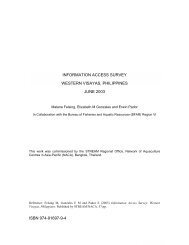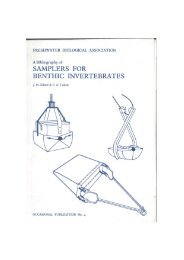Download - Aquatic Commons
Download - Aquatic Commons
Download - Aquatic Commons
Create successful ePaper yourself
Turn your PDF publications into a flip-book with our unique Google optimized e-Paper software.
Mollusca—W. G. Lyons Macroinvertebrate Checklists Camp et al. 1998<br />
unreferenced names (e.g., Nassarius sp. A). On an encouraging<br />
note, several of these species are the subjects<br />
of ongoing studies, so names for some of them may be<br />
available soon.<br />
Copies of the draft list were sent to three reviewers<br />
(see acknowledgments), each of whom provided<br />
comments that improved the final document.<br />
References<br />
The accompanying compendium of references presents<br />
citations for nearly 1,100 books, journal articles,<br />
dissertations, theses, contract reports, and popular articles<br />
containing information on the classification,<br />
identification, distribution, life history, and ecology of<br />
the shallow-water mollusks of Florida.The list is by no<br />
means complete. For example, the classic works in<br />
which many of Florida’s most well-known mollusks<br />
were described (e.g., the works of Linnaeus, Gmelin,<br />
Lamarck, Say, and others) have been omitted, although<br />
an attempt has been made to include early faunal surveys<br />
that documented and described Florida species<br />
(e.g., Conrad, 1846; Calkins, 1878; Dall, 1884). Many<br />
popular guides to the identification of Florida mollusks<br />
have been listed, but some are included principally<br />
for their historical value (e.g., Aldrich and Snyder,<br />
1936; Morris, 1947), and some of the less useful paperback<br />
guides to seashells have been omitted.<br />
Likewise, most of the popular guides to worldwide<br />
seashells have been omitted, even though some of<br />
them include information on Florida shells. Many papers<br />
concerned only with the mollusks of Florida’s<br />
deeper-water shelf and slope have also been omitted.<br />
Papers describing the births, romances, diets, interspecific<br />
associates, competitive struggles, deaths,<br />
and similar facets of the natural history of Florida mollusks<br />
have been included on the assumption that such<br />
information can lead to a better understanding of the<br />
organisms by those who would study or manage them.<br />
On the other hand, reports of the ordinary data of<br />
fisheries (effort, landings, and economics) have been<br />
excluded, as such information is generally available<br />
elsewhere. Also excluded are papers on the more complex<br />
aspects of molluscan biology, such as anatomy, embryology,<br />
and biochemistry. Thus, a paper on prey<br />
preferences of a predatory gastropod would be included,<br />
but a paper describing the cell structure of<br />
that predator’s stomach wall would not.<br />
One very useful source of information on Florida’s<br />
molluscan fauna is S. D. Kaicher’s Card Catalogue of<br />
World-Wide Shells, a series of 60 card packs published<br />
individually between 1973 and 1992. Each pack consists<br />
of approximately 108 3 × 5 cards dedicated to a single<br />
family (or occasionally two related families) of marine<br />
gastropods, and each card presents the name, range,<br />
diagnostic comments, and illustrations for a different<br />
species of that family. Nearly all of the packs contain<br />
cards treating species of the Florida fauna, but such information<br />
is readily available elsewhere for some families<br />
(e.g., Strombidae), so those packs are not cited<br />
here. In other cases, however, the information in the<br />
card packs is superior in accuracy and quality of illustration<br />
to any other information on those species,<br />
and an effort has been made to list the most pertinent<br />
of those packs. Examples of packs especially useful as<br />
identification aids for Florida species include those<br />
on Olividae (especially Olivella), Nassariidae, and Turridae.<br />
A few articles from shell club newsletters have<br />
been included as examples of this information resource.<br />
Such articles can provide a wealth of information<br />
on local faunas, and in many instances they constitute<br />
the only record of local occurrence for a given<br />
species. Many useful and informative articles have<br />
been published in Shell-O-Gram, the newsletter of the<br />
Jacksonville Shell Club, in Seafari, the now-defunct<br />
newsletter of the Palm Beach County Shell Club, and<br />
in similar publications. Some of those newsletter articles<br />
have been later cited in scientific reports, but this<br />
is not peer-reviewed literature, and such articles<br />
should be used with caution. On the other hand, some<br />
of the shell collectors who write these articles are more<br />
knowledgable identifiers of local fauna than are some<br />
of the biologists who identified mollusks for some of<br />
the environmental surveys cited in the present compendium.<br />
In fact, there seems to be an increasing tendency<br />
towards the publication of incorrect molluscan<br />
identifications in the peer-reviewed scientific literature,<br />
especially in papers reporting general faunal assessments,<br />
and some of those papers listed here contain<br />
remarkable errors. The best rule is to accept that information<br />
which seems reasonable and seek verification<br />
for that which does not, regardless of the source.<br />
Acknowledgments<br />
Dr. Paula M. Mikkelsen, Department of Invertebrates,<br />
American Museum of Natural History, New York, and<br />
Dr. James F. Quinn, Jr., Florida Department of Environmental<br />
Protection, Florida Marine Research Institute,<br />
St. Petersburg, each reviewed the entire draft list,<br />
and Dr. Kerry B. Clark, Department of Biological Sciences,<br />
Florida Institute of Technology, Melbourne, reviewed<br />
sections on aplacophorans and heterobranch<br />
and opisthobranch gastropods. Each of the reviewers<br />
has extensive experience working with the marine<br />
molluscan fauna of Florida, and each contributed valuable<br />
comments that improved the list.This effort also<br />
6 FMRI Technical Report TR-3



